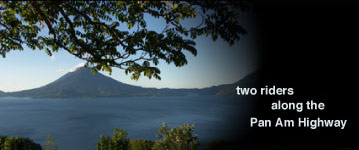
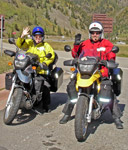
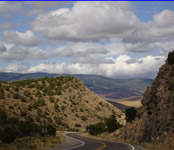
view corresponding gallery | previous entry | next entry
entry 19: panama 04/06/06
Crossing into Panama was very similar to crossing into Costa Rica. The exit from Costa Rica was completed within an hour and at one main complex and entry into Panama was also housed in one building. Again, allow at least two hours for processing. Fumigation papers in Panama are very important as you will be asked by police checkpoints on down the road to prove you have been fumigated. In reality we paid for, but were never sprayed for, fumigation. We looked for a fumigation station and the only one we found was for semi-tractor trailers and it washed the big trucks from top to bottom. Off we went into Panama - and found travel along the Pan-Am was now on a four-lane concrete highway. The speed limit was 60mph and traffic was fairly light. Sunshine is now almost directly overhead and without the GPS your sense of direction at high noon is thrown way off. Add the fact that after five months we are no longer traveling south but due east and you give up trying to figure this out and just follow the road.
The first stop was in Panamas second largest city, David (pronounced Dah-veed), and after riding around town for about an hour looking for a hotel, we spotted a pleasant looking one on a corner. I jumped off the bike, hurried past the security guard, swung open the door and found myself face-to-face with about 200 slot machines. My Mom would have been happy to see them, but standing there in my red riding suit with helmet in hand, I was drawing stares that were a bit embarrassing. Back out at the bikes Lynne had figured out that the hotel was actually across the street and it turned out to be way too expensive anyway. But the good folks there did recommend the hotel Puerta del Sol at $27 a night, which turned out to be quite nice.
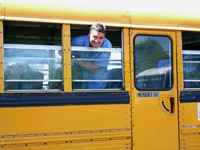 |
| On the bus to Boquete. You see many retired school busses here in Central America |
David is a bit gritty and the town square was closed for renovations so we decided to take a bus trip north to the small town of Boquete. As you may know from earlier journal entries, we enjoy bus rides because they allow us to see the country side without having to watch the road and it allows us to observe our fellow commuters going about their lives. However, having the bus pull over and pick-up a gentleman carrying a five foot chainsaw and a machete probably doesn’t happen too often in the states - but then again a lot of people in Central America carry machetes and wear knee high rubber boots.
Boquete is about an hours ride from David and the $1.45 ticket price is a deal. The town itself is known for its Café Ruiz - a family owned coffee plantation and café. The other commodity in abundance in Boquete is expatriates. We had seen the town advertised in some Panamanian produced guide books and we spoke first-hand to a lady who had read the same guide books before moving from Tennessee. She was told that she could live comfortably on $500 a month, the minimum amount of guaranteed income (social security), that must be documented to the Panamanian government before entry, but after getting to Panama she found that amount was based on meals consisting mostly of beans and living without any of the comforts she was accustomed to. She said $800 a month let her live in a better lifestyle. I admired the fact that she was willing to take a risk in her retirement years. There is a support group for U.S. retirees in Boquete but I got the feeling she should have taken a trip to Panama before committing to retirement down here - she really seemed to be missing the comforts of home. I wonder if her kids have the spare bedroom ready?
Back on the bikes the next day, the fine four-lane highway continued and we were able to put in a couple of hundred miles in an easy four hour ride. The temperature started to rise - averaging 102, but in one valley the wind died down and my dash mounted thermometer hit 114. We decided not to push into Panama City, still about 100 miles away, and stopped at a small hotel in Pononame. We really do enjoy hotel rooms that cost under $20, but there is usually a price to be paid in either bedding quality, air circulation or in this case, ants. We had learned our lesson about leaving open foods in the rooms (instant Entomology class) but it was not food that attracted the string of ants this time. It was my helmet. We have been using skull caps (product name Slic) to keep the inside of our helmets clean, so the ants were not attracted to the foam inside the helmet, but were INSIDE the structure of the helmet itself, having gained access through the air vents. I spent about a half hour tapping my helmet and then squashing whatever crawled out.
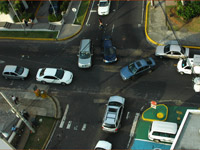 |
| A birds eye view of a Panama City intersection - and this is a mere side street! |
As you approach Panama City you cross the Bridge of the Americas, a large suspension bridge, looking much like the Golden Gate Bridge in San Francisco, high enough to let all forms of sea-going vessels pass underneath. This is also the entrance to the western side of the Panama Canal. The decision to wait the day before heading into Panama City and starting fresh paid off as we soon found ourselves once again trying to read road signs and use GPS compass directions on roads that had few signs, slanted to all angles, and merged with other slants every six blocks. To make matters worse, there are few traffic lights and grid lock is common. We rank Panama City as the most confusing (read: crazy) city, so far, to ride around in. Once again we used the services of a taxi driver and five minutes plus $3 later we arrived at our hotel.
We settled in and immediately found a travel agent to help us get to the two sights we did not want to miss - one to travel the canal and the other go to the islands just off of the northern coast of Panama, called the San Blas Archipelago.
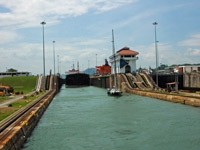 |
| A view from the rear of our boat as we exited the Pedro Miguel locks. |
The Canal tour started by taking a bus ride northeast and then boarding a ferry boat that headed back to the Pacific Ocean. We knew little about the canal before this trip and I’ll try not to put in too many facts and figures when describing this adventure, BUT…this was quite an achievement by man. The narrow lake in the middle of the canal is man made, created by damming a river and then using steam shovels and dynamite to cut a path through a low mountain range. This straight and narrow section is one of the sections that most people have seen in photos, the other popular section of course being the locks. My pre-tour conception was that the locks had water pumped in and out of them to raise and lower the water levels. This is why I am not an engineer, because the guys who made this happen had a much simpler solution - gravity. Because the ditch that was cut through the low mountains is about 86 feet higher than sea level, three locks are required to bring the ships up or down. The process always starts by releasing lake water (26 million gallons in 8 minutes) - either the lake fills the top locks or the next higher lock fills the lower ones. Electric trains that work like tugs insure the movement of the bigger boats is smooth and safe. Smaller boats, such as yachts and sailboats, are put through in groups with the largest vessel being moored to the side of the lock with the smaller ones tied up to it. Entrance to the canal is on a first-come/first-served basis, with an average wait-time of 24 hours to gain entrance. Once in the canal, the entire passage takes about 8-10 hours. Currently, over 14,000 vessels pass through the canal each year. The cost of passage is hefty and is calculated by weight; miniumum is $500 and the highest fee to date was a passenger cruise ship with a $240,000 bill of passage.
The canal ride is a great experience for anyone interested in learning about and experiencing the canal. A few days later we went to the Mira Flores Locks museum, located next to the western locks, and would only recommend this museum to people who have only a few hours to see the canal – it was a bit of a tourist trap. You can watch the ships move through two locks and the museum has four floors of exhibits, but only about a floor and a half have anything to do with the canal. The rest is dedicated to the Panamanian tourism industry. I also noticed Panama trying pretty hard to downplay the role the U.S. had in building and maintaining the canal for 85 years - but then again it is their museum.
A few days later we flew to the San Blas Islands. Our day started with a 3:45 a.m. wake-up call so we could catch a 4:30 cab to be on a puddle-jumper flight at 6:00. I really don’t remember much of the flight except that the plane was a small twin engine model, it made two landings before our island and half of the passengers were tiny Kuna women (the Kuna people are short, second only to the African Pygmy), dressed in brightly colored skirts, calf wraps and hand-made quilted tops.
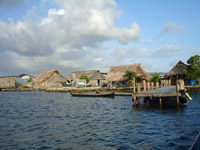 |
| Arriving at the Ukuptupu Lodge. |
After landing on an extremely short runway we were put on a long, narrow boat that took us to a small island that supports about ten grass huts. This was the Ukuptupu Lodge, operated by Juan Garcia and his very hospitable family. It is hard to describe the setting we found ourselves in because the water was so clear that when you scooped it into your hand it looked like drinking water – not a speck in it. And when you looked out at the sea the turquoise green turned from light blue to dark blue. The horizon was a mix of white puffy clouds and small, palm covered islands ringed with white sand and small, dugout canoes topped with kite shaped sails crossing from one island to the other. The warm sunshine and light breeze just added to the dream-like setting. It was a tropical paradise like we have never seen.
Our hut, on the other hand, might better be described as primitive rather than paradise. It was built on stilts directly above the water which made it interesting when trying to fall asleep. When you sleep on a boat, the sounds of the water and the rocking of the boat are in sync, sort of lulling you to sleep. That night however, we had the sound of the waves, but no rocking movement. We both lay there waiting for the rocking to start and it never did – creating a sort of equilibrium imbalance. This lasted for about five minutes and then we were both dead to the world. The beds were of plywood and foam and we shared them with the little native iguanas. The toilet was down the dock and held a bottomless toilet open directly to the sea and a large tank full of rainwater for “jug-showering”. (Note: no swimming is done close to here).
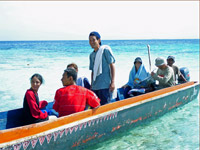 |
| Getting ready to leave Dog Island after a wonderful day. |
After checking out our digs, we changed into our swimsuits, hopped back into the outboard motor-powered longboat with a couple from Austria and five youth volunteers from Japan and headed out to a deserted island for some beach time. What somebody neglected to tell us was that we would be dodging pretty-good-sized waves in this overgrown canoe. We quickly became soaked and were hoping every island we bounced past would be our stop! The kids from Japan soon started into some rousing renditions of Japanese tunes - and they could actually sing! Music does soothe the savage beast and soon we settled down and enjoyed the last 30 minutes of our trip to “ Dog Island”. The island was not completely deserted as it had a grass hut that offered a few cold drinks and the caretaker of the island made and sold hand-quilted molas there as well. We spent the day swimming and exploring the island, enjoying a delicious rice and chicken (Lynne) and squid (me) lunch that the Ukuptupu had sent along with us. Then it was back onto the SS Slap-A-Lot for the trip back to our island home. We stopped on another island for a look at the local handicrafts – mostly more of the beautiful molas. The Kuna Indians have developed a method of quilting that involves delicate stitching and layering brilliantly colored cloth squares. Although this is usually Lynne’s kind of thing I really thought the handy-work was exceptional. The Kuna women (and a few men) spend many hours a day designing and sewing the squares depicting images from their everyday lives.
That night we enjoyed a meal with the couple from Austria - the second half of which was by candlelight because the gas operated generator quit, leaving us in the dark – and I mean total darkness. We finally felt our way back to the hut for a candle – thank goodness one of the Japanese kids smoked, or we would not have been able to light the candles to see our plates. We went to bed knowing that we had to be up at 6am for the boat ride back to the only slightly bigger island to catch the one-time-daily plane back to Panama City. No computer generated seating assignments on these planes – the first 15 people get on. They actually turned the last few hopefuls away who were behind us – we’re not sure when they got another chance. It was 24 hours full of so much, yet so little. I think Lynne summed up the excursion the best when she said “If I ever want to find a place to get away from it all and do nothing, this is the place I’d go to.” It is, however, not for those who expect turned-down sheets and chocolates on their pillow!
By the 5th of April we had seen and done a lot of what we wanted to in Panama and it was time to get ourselves and the bikes to Ecuador. Our first priority was shipping the bikes. We researched the resources noted on horizonsunlimited.com and contacted Ricardo Rocco, an avid motorcyclist in Ecuador, and ended up hiring Girag, an air cargo company, to fly the bikes to Quito. They said no bike preparations were needed, but having read about others experiences when shipping bikes I removed most of our gear from the hard panniers and placed our soft tank panniers inside them, along with our riding suits. The two helmets went in one top box and our tank bags went in another. Most of our clothes, computer, camera, etc went with us in the three cheap suitcases we bought in Panama City.
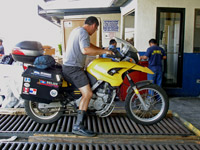 |
| Getting the bikes weighed at Girag - and making a fashion statement as well. |
We arrived at Girag on Wednesday morning and were asked about our fuel levels (we had purposefully used all but approximately ½ gallon), but we were not asked to disconnect the battery. After removing the mirrors I ran the bikes up on the scale, which was made of roller bars which made stopping the bikes on top interesting, and then rode them to a Hazardous Materials staging area in their warehouse. No crating required – just leave the steering unlocked and take the keys. It was expensive at $650 per bike (cash only) but the whole process took only about two hours, was almost hassle free, and they promised the bikes would be in Quito in two days.
The shipping schedule meant we needed to arrive in Quito on Thursday in order to pick up the bikes on Friday - as we were strongly advised not to leave the bikes in customs any longer than necessary. We left Girag and took a taxi to get our customs stamps for exporting the bikes and then headed to the airport to get our airline tickets to Quito. We had looked online the day before and found ticket prices for $327 per person on Copa Airlines, so we were a little disappointed when the counter agent quoted a price of $393. She said she couldn’t give us the on-line discount so we ended up back at our hotel to book our flight on-line. Well, it turned out you can not book tickets to Quito the day before over the internet (did the counter agent know that?) and our stomach acid levels started to rise as we had just sent our bikes flying off to Ecuador. It was now 2 o’clock in the afternoon and we almost ran out of the hotel to find a travel agency. When we did find one it ended up costing the same as we were quoted at the airport ($70 more than it would have cost to book online the day before) BUT it was on Avianca air which had a layover in Bogotá, Colombia. So things turned out well because we secured tickets to Quito with a bonus of stopping in Colombia! Next up...bike recovery in Quito.
thoughts from lynne
On the bus ride to/from Boquete that Tom mentioned, I noticed that I was the ONLY person on the bus (probably 50 riders) that did not have dark-brown/black hair. The fact that my red hair draws attention south of the US border is nothing new to me. What struck me here was the how different my view would have been had I been on a bus in Denver or New York City. The US does provide diversity in hair styles and colors!
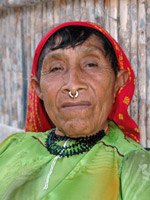 |
| A contemporary Kuna |
I was fascinated by the Kuna people of San Blas - there is quite a history behind these people. Briefly, as I understand it, they started in the mountains of Panama long before European explorers came to the Americas. They left the hills for the San Blas Archipelago in an attempt to evade malaria, cholera and other diseases brought by the Spanish. For about 200 years they fought small land-wars with the Spanish explorers on the northern coast of Panama, followed by about 100 years of peace. After Panama’s independence from Columbia in 1903, the assaults on the Kuna came from different arenas - the Panamanian government anxious for the Kuna to adopt their ways of life; the US military in town to build the canal and in need of their natural resources; and religious missionaries trying to convert the Kuna to Christianity. The Kuna tried several avenues to protect their lands and culture, finally resorting in 1925 to violence, killing many Panamanians in their territory. Following this rebellion, with the help of the US, they negotiated and received a semi-autonomous stature from Panama. They gained almost complete control over their land, which is called Kuna Yala. They won the right to form their own government and also to elect representatives to the Panamanian congress. Still today they are fiercely independent – ownership of any of the 356 islands is restricted to members of the Kuna Tribe. Their strife seems to have been successful - they are one of the few indigenous tribes in the Americas (if not the world) to have had such success in retaining their autonomy and culture.
Our last days in Central America – as I look back:
What will I miss? The flora and fauna without a doubt. So many times I stop and stare at something so unique and beautiful - trying to make a mental picture that I’ll be able to conjure up when I’m old & cranky in the nursing home.
What do I hope to leave behind? The BUGS. Living in dry, high Denver for 20+ years has spoiled me with its lack of things that go crawl in the night. Central America more than makes up for it. Everywhere we went, there was some new detestable species of insect. The final straw was in Manuel Antonio when I found some in my peanut butter. Some things are sacred.
What challenged me? I think the slower lifestyle was difficult to become accustomed to. There is no multi-tasking here. One thing at a time, and in its own good time. I hope that I have become a more patient (dare I hope even tranquil) person as a result of my time spent here.
A surprising revelation – really enjoying learning the history of the area. Tom is the history buff – not me! I hated history in school – who wanted to learn about the past when there is so much going on in the present? But... something about learning all this when you are standing where it all happened and from the ancestors of the people it affected, makes my mind jump into action. I’m learning so much, I might finally prove a worthy opponent to Bill Betts in the game of Trivial Pursuit!
I look forward to - South America. The fact that we are flying there really drives home the point that we will be on another continent. For the first time in my life, I will be in the southern hemisphere – south of the equator! Yes, I do count my blessings pretty often these days.
On to the other side…

Copyright © 2005 All content and photography are the property of Tom and Lynne Gefre.
Contact us if interested in publishing or reusing any material.